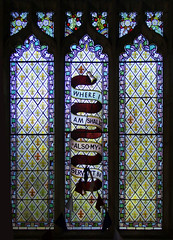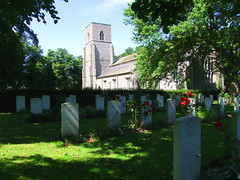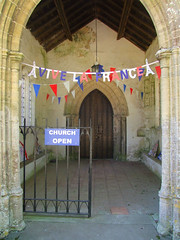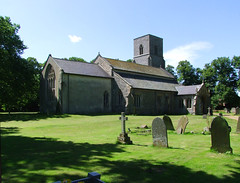| |
|
St Mary,
Great Bircham Not a large village, though it may seem so
after a few hours cycling through the little hamlets that
bury themselves in the valleys of the rolling north-west
Norfolk landscape. Technically there are three Birchams,
although in reality the other two are just outer fringes
to the Great one, and St Mary is the big church at the
heart of it all.
A big
church, yes, but unfamiliar to East Anglian eyes in that,
despite its wide aisles, there is no clerestory, and the
big west tower is set against the end of the south aisle,
which must have been the site of the original church.
Mortlock observes that the church has a curiously
shuttered look, which is exactly right. So often
with large churches in East Anglia you enter a building
of light-filled and perpendicular openness, but here, as
you approach the grand north porch, you have no inkling
of what secrets may be inside.
| In
fact, you enter a church shot through with light,
because the offsetting of the tower allows one of
the biggest west windows in Norfolk. Added to the
fact that there is very little coloured glass
inside, you can see that a clerestory would have
been an unnecessary luxury. Indeed, light is the
principal motif of the church, no shadowy worship
here but that Perpendicular triumphalism of the
late medieval period which, stripped of its
fittings, can leave a rather barn-like feel,
which the elegant 19th Century box pews go some
way to ameliorating. Even so, the modern
congregation must rattle around in here. In the
north aisle, John and Harriet Layland were for
over forty years master and mistress of the
schools of this parish. Just to the east,
their son Robert Jasper Layland was, in 1867, killed
at Wigan, Lancashire aged 15 years. What a
fascinating story those two memorials tell.
Across the church in the south aisle, 21 year old
Sidney Wharton was killed on the first day of the
Somme.
To
the east of the church is a Commonwealth War
Graves Cemetery for the Second World War,
remembering both the airmen of RAF Bircham Newton
and the German air crews who tussled with them. A
plaque on the wall tells us that the Cross of
Sacrifice here was the first to be erected after
that war ended.
|
|
 |
|
|
|



